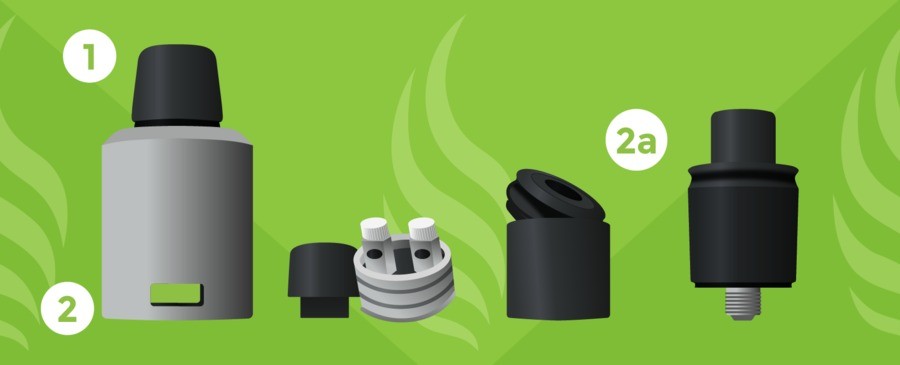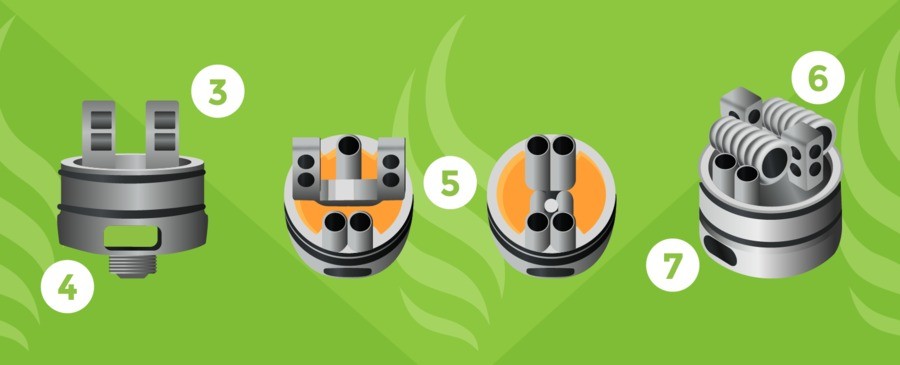Learn the differences between RTAs and RDAs and which type of rebuildable atomizer is right for your vaping needs.
If you’re thinking about branching out from standard kits and want to make your own coils for the rebuildable atomizer on your e-cigarette, read our guide to RDA vs RTA vaping, so you can decide what’s best for you.
Why should you customise?
There are many reasons people want to customise their e-cigarette, but the main advantages are that you get more flavour from your e-liquid, have more control over the power behind your vape, and can get bigger vaping clouds.
For both a RDA vape and RTA vape, you will build your own coil and wick, which can be fiddly until you get used to it, but don’t let that put you off! Making your own coils for your rebuildable atomizer is a rewarding experience, and you’ll soon find it an easy task.
If you’re into sub-ohm vaping, then building your own coils for your RTA or RDA is especially good for you as you'll find that you'll be spending less money buying the materials to build, than you would do if you use and buy prebuilt coil heads.
What is RTA Vape?
RTA stands simply for Rebuildable Tank Atomizer. The main difference between RTA vaping and RDA atomizers is that RTAs have a tank that holds your e-liquid. E liquid capicity can range from 2ml up to 6ml, and vary based on the make and brand of RTA you want to use. The choices available are large and there's an RTA for everyone that will suit their functional needs as well as style.


Components of RTAs
1. Drip tip - the hollow mouthpiece that you use to draw on when vaping on your vape mod. Drip tips come in all kinds of colours and designs, as well as diameter (wide or narrow bore). Often made with Delrin, to remain cool and comfortable against your lips, but also available in pyrex glass or ceramic which perform better at resisting heat.
2. Cap – most tanks are top filled for convenience, the cap unscrews from the top section which holds the glass tube in place. Once unscrewed, slots/holes can be accessed to fill the tank with a unicorn bottle and smaller glass drippers.
3. Chimney – with this particular RTA the chimney is in two parts, but often the chimney would be part of the tank top section and screws into the top of the chamber.
4. Glass tube – this is held in place by the top section and the deck section.
5. Chamber – this screws into place over the deck, posts, coils and wick. The slots in the chamber (juice holes) allow the liquid to flow down (while regulated by the vacuum created in the glass tube) onto the wick.
6. Deck and base section – much like an RDA deck, you can see the posts but the juice wells are no longer present, instead replaced with a housing for the wick. The base section is a hollow chamber the feeds up into the deck to provide air flow holes that blow onto the coil to aid in catalysing the heating of the coil and juice.
The pros:
- The tank means you can hold more e-liquid than juice wells in an RDA.
- You don’t need to drip as often as with RDAs
The cons:
- Tanks can be susceptible to leaking if not wicked correctly or left on their side
- Flavours can be muted when compared to flavour on an RDA!
What is RDA Vape?
RDA stands for Rebuildable Dripping Atomizer. These differ from the RTAs as they allow you to drip e-liquid directly onto the e-cigarette wick.




The Components of RDAs
1. - Drip Tip
2. Cap -
2a. Some RDAs come with a cap that has a removable top known as a chuff cap – this allows the top to be removed, when dripping, without having to remove the whole cap, or allow the cap to be replaced with a different colour for customisation purposes.
3. Posts – there are many post configurations available. Some decks can also be postless.
4. Deck – the base part of the RDA holds the deck. The area where the posts are is considered as the deck or “build deck”.
5. Juice well – the areas marked are known as the juice wells. Depth and size can vary. The wells can hold a small amount of e-liquid.
6. Coil – the heating element, can come in single, double, quadruple, octuple, etc. configurations.
7. Wick – the cotton wicking material that holds and draws the juice, via convection, is often fed through the coil (sometimes around the circumference on builds such as the “Nano Dragon” coil).
The pros of RDAs:
- You'll get better flavours from a dripping atomizer as the vapour has shorter to travel to your mouth
- Dripping directly onto the wick means you can vary flavours regularly
The cons of RDAs:
- You’ll need to drip more often than with an RTA, as there’s no tank for e-liquid - the juice well holds significantlly less liquid
- Susceptable to leaking if over filled will e-liquid
What next?
When you’ve made your choice between a Rebuildable Tank Atomizer (RTA vape uk) and a Rebuildable Dripping Atomizer (RDA vape uk), there are a few things you should consider when you’re building your kit:
- Look at the size of the item – choose a bigger deck space for your first build will be much easier than trying to build on a compact space.
- Spend some time researching coil and wick materials, so you can be sure you’ve chosen the right one for your RTA or RDA atomizer.
- You will need to check the resistance of your coil using an ohm reader to ensure it’s safe and won’t damage your atomizer. (It’s worth doing this regularly when you use your RTA or RDA too!)
- Get a bit of an understanding of Ohm's Law before building and especially firing your mod. We would recommend reading steam-engine.org and using their resources to plan out your coil build.
- Check out our guide to coil building for some helpful tips!
- Invest in a good battery to make the most of your RTA or RDA experience - please ensure that you've read follow our battery safety guides
- Watch a few coil building tutorials on YouTube and get an overall idea of what to expect with your first build
Once you’ve chosen your atomizer and materials, and invested in decent kit, you’re ready to get started. Who knows, your journey into RTA or RDA vaping may even lead you to competitive sub-ohm events.


